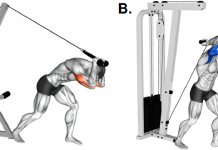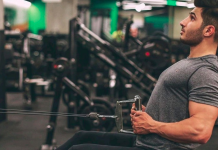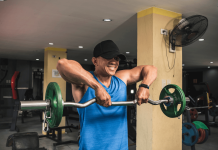Maximize Your Chest Gains with Effective Cable Chest Workouts
Cable chest workouts offer a powerful way to sculpt and strengthen your chest muscles. By using the cable machine’s constant tension, you can target specific areas of your chest, including the upper and lower regions. In this comprehensive guide, we’ll explore various cable chest exercises to help you achieve a well-defined chest and boost upper body strength.

Cable Chest Exercises
Maximizing Your Workout Potential Cable chest exercises are a versatile and effective addition to any chest workout routine. They allow you to engage stabilizer muscles while maintaining constant tension throughout the movement, resulting in better muscle activation and growth. Let’s dive into some of the best cable chest exercises:
- Upper Chest Cable Fly: Targeting your upper pectoral muscles, the upper chest cable fly is performed by setting the pulleys at the highest position. Stand between the cables and hold the handles with palms facing downward. Extend your arms outwards in a controlled motion, focusing on squeezing your chest at the peak of the movement. Slowly return to the starting position and repeat for the desired number of repetitions.
- Lower Chest Cable Press: To engage the lower pectoral muscles, adjust the pulleys to the lowest position. Face away from the cables and hold the handles at chest level with your palms facing downward. Push your arms forward until they are fully extended, emphasizing the contraction in your lower chest. Gradually bring your arms back to the starting position and repeat.
- Cable Crossover Workout: The cable crossover is an excellent exercise for overall chest development. Set the pulleys at shoulder height and stand in the middle. Hold the handles with palms facing upward. With a slight bend in your elbows, bring your arms forward and cross them over each other in front of your body. Slowly return to the starting position, feeling the tension in your chest throughout the movement.
Perfecting Form
Key to Optimal Results To make the most of your cable chest workouts, proper form is crucial. Focus on maintaining a steady pace, and avoid using momentum to complete the exercises. Perform each movement in a controlled manner, emphasizing the contraction in your chest muscles. Remember to breathe steadily throughout the workout to ensure adequate oxygen supply to your muscles.
Creating a Cable Chest Workout Routine Incorporating cable chest exercises into a comprehensive workout routine is essential for balanced muscle development.
Consider combining cable exercises with free-weight chest exercises to target different angles of your chest effectively. Here’s a sample cable chest workout routine:
- Upper Chest Cable Fly: 3 sets x 12 reps
- Lower Chest Cable Press: 3 sets x 10 reps
- Cable Crossover: 4 sets x 10 reps
- Barbell Bench Press: 3 sets x 8 reps
- Dumbbell Pullover: 3 sets x 12 reps
- Push-Ups: 3 sets to failure
Safety First
Proper Cable Machine Setup Before starting your cable chest workout, ensure that the cable machine is correctly set up. Adjust the pulleys to the appropriate height for each exercise, and check that the handles and attachments are secure. Always start with a lighter weight to warm up and gradually increase the resistance as you progress.
By incorporating cable chest workouts into your fitness routine, you can achieve a well-defined chest and enhance upper body strength. Remember to focus on proper form and controlled movements for optimal results. Mix cable exercises with free weight variations to target all areas of your chest effectively. With dedication and consistency, you can unlock the power of cable chest exercises and take your chest training to new heights. Stay tuned for more workout tips and techniques to elevate your fitness journey!
Unlocking the Benefits: Advantages of Cable Chest Workouts
- Targeted Muscle Activation: Cable chest exercises allow for precise targeting of specific chest muscles, including the upper, lower, and inner regions. The constant tension provided by the cable machine ensures maximum muscle activation throughout the entire range of motion, leading to better muscle development.
- Stabilizer Muscle Engagement: Unlike traditional free-weight exercises, cable chest workouts require stabilizer muscles to stabilize the cables and handles during movements. This engagement not only enhances overall muscle strength but also improves joint stability and balance.
- Reduced Risk of Injury: The controlled nature of cable exercises minimizes the risk of sudden jerks or unbalanced movements, reducing the likelihood of injuries. This makes cable chest workouts a safer option, especially for individuals with joint issues or those recovering from injuries.
- Versatility and Variety: Cable machines offer a wide range of attachment options, allowing you to perform various chest exercises with different grips and angles. This versatility adds variety to your workouts, preventing plateaus and keeping your routine engaging.
Tips for Optimal Cable Chest Training
- Mind-Muscle Connection: Focus on establishing a strong mind-muscle connection during cable chest exercises. Visualize your chest muscles working throughout each repetition, emphasizing the contraction and extension.
- Progressive Overload: To promote muscle growth, gradually increase the weight used in your cable workouts. Aim for a weight that challenges you within the desired rep range, but still allows for proper form and control.
- Full Range of Motion: Ensure that you perform each cable chest exercise through its full range of motion. This allows for better muscle activation and helps you achieve more significant gains in strength and size.
- Rest and Recovery: Allow sufficient rest between cable chest workouts to promote muscle recovery and growth. Adequate sleep and nutrition are also crucial for optimal results.
Nutrition for Chest Muscle Growth
- Protein Intake: Protein is essential for muscle repair and growth. Incorporate lean protein sources like chicken, fish, tofu, and beans into your diet to support chest muscle development.
- Healthy Fats: Include healthy fats from sources like avocados, nuts, and olive oil to promote overall muscle health and aid in nutrient absorption.
- Hydration: Stay well-hydrated to support muscle function and recovery during and after cable chest workouts.
Cable chest workouts offer a dynamic and effective way to build a strong and well-defined chest. By targeting specific areas of the chest with constant tension and engaging stabilizer muscles, you can achieve impressive results. Remember to prioritize proper form, rest, and nutrition to maximize the benefits of cable chest exercises. With dedication and consistency, you’ll be well on your way to unlocking the full potential of your chest muscles and reaching your fitness goals.
Stay tuned for more fitness tips and workout guides to enhance your training journey and lead a healthier, stronger life. Get ready to take charge of your chest workouts and witness the transformation in your physique and performance. Happy training!
FAQs: Cable Chest Workouts
Q1. What are cable chest workouts, and how do they differ from traditional chest exercises?
A1. Cable chest workouts involve using a cable machine to target the chest muscles with constant tension throughout the movement. Unlike traditional free-weight exercises, cable workouts engage stabilizer muscles, promoting better muscle activation and growth.
Q2. Can cable chest exercises help build upper chest muscles effectively?
A2. Yes, cable exercises like the upper chest cable fly specifically target the upper pectoral muscles, aiding in the development of a well-defined upper chest.
Q3. Are cable chest workouts suitable for beginners?
A3. Absolutely! Cable chest exercises can be adapted to suit all fitness levels. Beginners should start with lighter weights and focus on proper form.
Q4. How often should I perform cable chest exercises in a week?
A4. The frequency of cable chest workouts depends on your overall workout routine. Aim for 2-3 sessions per week, allowing enough rest between sessions for muscle recovery.
Q5. Can cable chest exercises replace traditional bench presses?
A5. While cable chest workouts are effective, it’s beneficial to include a mix of exercises in your routine for balanced muscle development. Both cable exercises and bench presses can complement each other.
Q6. How do cable crossover workouts benefit chest muscles?
A6. Cable crossovers are excellent for overall chest development as they allow for a wide range of motion, engaging multiple chest muscles simultaneously.
Q7. Can cable chest workouts help with correcting muscle imbalances?
A7. Yes, cable exercises can address muscle imbalances by targeting specific areas of the chest, promoting symmetry and balanced development.
Q8. Should I perform cable chest exercises before or after other chest exercises?
A8. The sequence of exercises can vary based on your workout routine. Some prefer starting with compound movements like bench presses, followed by cable exercises for isolation.
Q9. How can I prevent injuries during cable chest workouts?
A9. Prioritize proper form and technique during cable chest exercises. Avoid using excessive weight, warm up before each session, and consult a fitness trainer for guidance.
Q10. Can cable chest workouts help with muscle definition?
A10. Yes, cable exercises create tension in the muscles, contributing to muscle definition and toning.
Q11. What are some common mistakes to avoid during cable chest exercises?
A11. Avoid using momentum to perform the exercises, rounding the shoulders, or locking the elbows during movements. Maintain control and focus on muscle contraction.
Q12. Can women benefit from cable chest workouts?
A12. Absolutely! Cable chest exercises are beneficial for both men and women, helping to strengthen and shape the chest muscles.
Q13. What role do stabilizer muscles play in cable chest exercises?
A13. Stabilizer muscles support and stabilize the body during cable chest exercises, enhancing overall muscle engagement and joint stability.
Q14. Can I perform cable chest exercises at home?
A14. If you have access to a cable machine or resistance bands, you can perform cable chest exercises at home.
Q15. Should I include stretching exercises after cable chest workouts?
A15. Yes, stretching after cable chest workouts can aid in muscle recovery and flexibility.
Q16. How long should a typical cable chest workout session last?
A16. A typical cable chest workout session can last 45 minutes to an hour, including warm-up and cooldown.
Q17. Can cable chest exercises help improve posture?
A17. Yes, cable exercises can contribute to improved posture by strengthening the chest and upper back muscles.
Q18. Can I perform cable chest workouts if I have shoulder issues?
A18. Individuals with shoulder issues should consult a healthcare professional or fitness trainer before attempting cable chest exercises to ensure safe and appropriate movements.
Q19. Can cable chest workouts aid in injury rehabilitation?
A19. In some cases, cable chest exercises can be incorporated into injury rehabilitation programs under the guidance of a healthcare professional or physiotherapist.
Q20. Are cable chest workouts suitable for bodybuilders?
A20. Yes, cable chest workouts are commonly used by bodybuilders to target specific chest muscles and achieve well-defined chest aesthetics.




